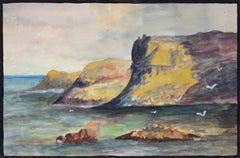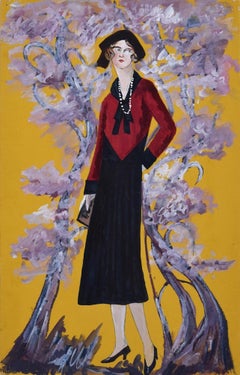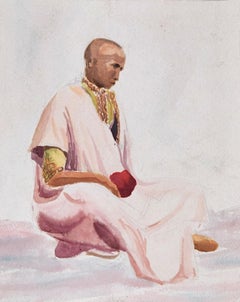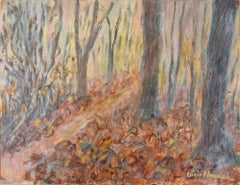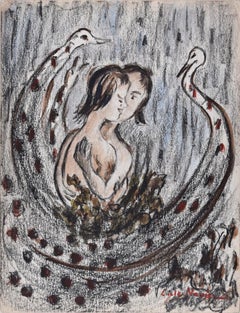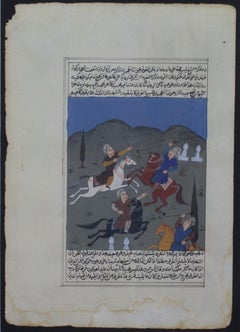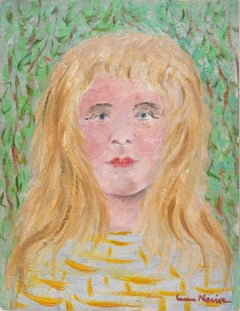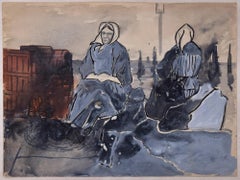Lucie Navier Art
to
1
6
5
5
1
1
Marine - Tempera on Paper by Lucie Navier - 1927
By Lucie Navier
Located in Roma, IT
Marine is a painting realized by Lucie Navier in the 1927.
Tempera on paper.
Mint conditions.
Impressionistic work realized with a Realistic technique and representing a natural...
Category
1920s Modern Lucie Navier Art
Materials
Tempera
Madame in the Blossom Garden - Tempera on Paper by Lucie Navier - 1931
By Lucie Navier
Located in Roma, IT
Madame in the blossom garden is an original painting realized by Lucie Navier in the 1931.
Original tempera on paper.
Very good conditions.
Colorful composition representing a f...
Category
1930s Modern Lucie Navier Art
Materials
Tempera
Poseidon - Ink and Tempera on Paper by Lucie Navier - 1933
By Lucie Navier
Located in Roma, IT
Poseidon is an original painting realized by Lucie Navier in 1933.
Original Ink and tempera painting on paper.
Dated on the lower right corner (23-6-2033).
Fair conditions except...
Category
1930s Modern Lucie Navier Art
Materials
Ink, Tempera, Watercolor
Muslim - Original Mixed Media on Paper by Lucie Navier - 1930s
By Lucie Navier
Located in Roma, IT
Muslim is an original painting realized by Lucie Navier.
Original tempera painting on paper. The sheet is glued on green cardboard (cm 30.5 x 25).
Very good conditions.
Colorful ...
Category
1930s Lucie Navier Art
Materials
Ink, Tempera, Watercolor
In the Woods - Original Oil Painting by Lucie Navier - 1931
By Lucie Navier
Located in Roma, IT
In the Woods is an original painting realized by Lucie Navier in the 1931.
Original oil painting on cardboard.
Hand-signed on the lower right corner.
Very good conditions.
Col...
Category
1930s Lucie Navier Art
Materials
Oil, Cardboard
Peacocks - Original Mixed Media on Paper by Lucie Navier - 1930s
By Lucie Navier
Located in Roma, IT
Peacocks is a painting realized by Lucie Navier in the 1930s.
Original tempera painting and pastels on cardboard.
Hand-signed by the artist on the lower right corner in red paintin...
Category
1930s Modern Lucie Navier Art
Materials
Tempera, Pastel
Related Items
Splash Girl - Original painting, Signed
By Philippe Pasqua
Located in Paris, IDF
Philippe Pasqua (1965-)
Splash Girl, 2010
Mixed medias : ink, watercolor and acrylic painting
Signed bottom right
Authenticated with the artist red stamp
On...
Category
2010s Modern Lucie Navier Art
Materials
Ink, Acrylic, Watercolor
Persian Illuminated Miniature with Four Figures Playing Polo in a Landscape
Located in Milwaukee, WI
The present illuminated folio page contains a fine miniature depicting four figures playing polo. Polo, also called 'chagun,' was the sport of kings and princes of central Asia and Iran, and the sport probably originated there in the 6th century BCE. Polo matches appear in a large number of early Persian texts, including in the writings of the 10th century epic writer Abu l-Qasim al-Firdawsi: He describes numerous polo matches in his famous 'Shahnameh' (The Persian Book of Kings). This particular illumination also is closely related to an example held at the Smithsonian Museum of Asian Art: a folio from 'Guy u Chawgan' (The ball and the polo-mallet) which shows a polo game with the dervish and the shah.
12 x 8.25 inches, artwork
19.75 x 15.88 inches, frame
accompanied on the back with an image of the verso
framed to conservation standards with a 100% rag silk-lined mat in a gold gilded frame
A Persian miniature is a small Persian painting on paper, whether a book illustration or a separate work of art intended to be kept in an album of such works called a muraqqa. The techniques are broadly comparable to the Western and Byzantine traditions of miniatures in illuminated manuscripts. Although there is an equally well-established Persian tradition of wall-painting, the survival rate and state of preservation of miniatures is better, and miniatures are much the best-known form of Persian painting in the West, and many of the most important examples are in Western, or Turkish, museums. Miniature painting became a significant genre in Persian art in the 13th century, receiving Chinese influence after the Mongol conquests, and the highest point in the tradition was reached in the 15th and 16th centuries. The tradition continued, under some Western influence, after this, and has many modern exponents. The Persian miniature was the dominant influence on other Islamic miniature traditions, principally the Ottoman miniature...
Category
19th Century Other Art Style Lucie Navier Art
Materials
Ink, Tempera, Laid Paper
$3,950
H 19.75 in W 15.88 in
Saturday Evening Post Illustration. “ The Devil’s Stronghold” Original Magazine
By Edwin Georgi
Located in Miami, FL
The work is mostly black and white to indicate that this is a night scene. On closer inspection, you will see areas of magenta and ivory throughout
The publisher's label on verso ide...
Category
1960s American Modern Lucie Navier Art
Materials
India Ink, Gouache, Pencil
$5,000 Sale Price
26% Off
H 15.5 in W 14.5 in D 16 in
Persian Illuminated Miniature with Three Hunters on Horseback in a Landscape
Located in Milwaukee, WI
The present illuminated folio page contains a fine miniature depicting three figures hunting while on horseback, an image meant to accompany a historic epic. During the medieval period, hunting was an important pastime of male nobility throughout the Islamic world. The Quran itself explicitly endorses hunting and the use of animals to aid in capturing prey: "Lawful to you are foodstuffs that are good to eat and any game that, at your wish, is captured by beasts of prey which train as you do dogs, according to the method that Allah has taught you, after you have spoken the name of Allah over it." (Q 6:4) Muslim princes and nobles enjoyed the chase of the prey via horseback, using bow and arrow, crossbows, and blowpipes to capture their prey Horseback riding itself trained young men in the necessary skills for armed combat and warfare, developing their speed and strength.
12 x 8.25 inches, artwork
19.75 x 15.88 inches, frame
accompanied on the back with an image of the verso
framed to conservation standards with a 100% rag silk-lined mat in a gold gilded frame
A Persian miniature is a small Persian painting on paper, whether a book illustration or a separate work of art intended to be kept in an album of such works called a muraqqa. The techniques are broadly comparable to the Western and Byzantine traditions of miniatures in illuminated manuscripts. Although there is an equally well-established Persian tradition of wall-painting, the survival rate and state of preservation of miniatures is better, and miniatures are much the best-known form of Persian painting in the West, and many of the most important examples are in Western, or Turkish, museums. Miniature painting became a significant genre in Persian art in the 13th century, receiving Chinese influence after the Mongol conquests, and the highest point in the tradition was reached in the 15th and 16th centuries. The tradition continued, under some Western influence, after this, and has many modern exponents. The Persian miniature was the dominant influence on other Islamic miniature traditions, principally the Ottoman miniature...
Category
19th Century Other Art Style Lucie Navier Art
Materials
Ink, Tempera, Laid Paper
$3,950
H 19.75 in W 15.88 in
“Central Park in Winter, 1949” Manhattan New York City Snow Day Sleds Children
Located in Yardley, PA
With a studied hand, Sloan captures the human theater of a snow-covered Central Park filled with bundled-up New Yorkers, sledding, walking, chatting, and caring for children. The exp...
Category
1940s American Modern Lucie Navier Art
Materials
Tempera, Oil, Masonite
$5,500
H 29.75 in W 35.75 in D 2 in
Woman Artist in Studio Pastel Drawing Polish Ecole D'Paris, WPA, Bezalel Artist
By Jacques (Jakub) Zucker
Located in Surfside, FL
Jacques Zucker was born in 1900 in Radom, Poland. He was a notably famous Jewish American artist mostly known for his expressionist figure paintings. In his young years he traveled t...
Category
20th Century Modern Lucie Navier Art
Materials
Pastel
Rabbit Hunters
By Roger Medearis
Located in Los Angeles, CA
Rabbit Hunters, egg tempera on Masonite, 12 x 9 inches, 1947, signed and dated lower left, signed, titled and dated verso “Rabbit Hunters Egg Tempera Roger Medearis 1947,” exhibited at Medearis' solo show at Kende Galleries, New York, in 1949 (Medearis’ record book, a copy of which is held by Vose Galleries in Boston, MA, indicates this is painting “No. 23” and that is was completed in 1947 and sold via Kende Galleries (at Gimbel Brothers...
Category
1940s American Modern Lucie Navier Art
Materials
Tempera, Board
Refreshment and Intermission
Located in Los Angeles, CA
This painting is part of our exhibition America Coast to Coast: Artists of the 1930s
Refreshment and Intermission, tempera on board, 11 x 19 inches, c. 1930/40s, signed lower middle, exhibited at Groom's one person show at Closson’s Gallery, Cincinnati, OH, March, 1943 (see The Cincinnati Enquirer, March 7, 1943, section 3, p. 4); provenance includes a private Ohio collection; presented in a period gold painted frame
About the Painting
Refreshment and Intermission is part of a series of paintings of Amish subjects Grooms started in 1938 based on his travels in Pennsylvania. These tempera works reflect the Regionalist impulse to paint local scenes far away from big cities. Focusing on both people and landscape, Grooms' compositions tell the stories of the uniquely American experience of the Amish. “Grooms paints the Amish people with as much understanding of type and appreciation of the plastic quality as any artist who has approached this challenging subject," noted the art critic for The Cincinnati Inquirer when reviewing Grooms' solo exhibition at Closson' Gallery, "In his current show, ‘Refreshment and Intermission,’ is a case in point. Here the absorbed concentration of people eating is described without an ounce of sentimentality. He has made the most of the interest between groups and of the conversations, both humorous and serious. The work has the quaint simplicity of a Lord’s Supper...
Category
1930s American Modern Lucie Navier Art
Materials
Tempera
Landscape. Oil on cardboard, Figurative, Nature, Muted colors, Polish art
By Magdalena Spasowicz
Located in Warsaw, PL
20th century figurative landscape oil on cardboard painting by Polish artist Magdalena Spasowicz. Artwork is in classic style, it resembles impressionism. Composition is painted with wide brush strokes. Colors are muted. Artwork depicts a rural landscape with a tree in the centre of the composition.
MAGDALENA SPASOWICZ Studied painting under prof. Jan Cybis and graphic arts with prof. Tadeusz Kulisiewicz at the Academy of Fine Arts in Warsaw. She received her diploma in 1953. Her works have been presented in numerous exhibitions in Poland and abroad, among others in Warsaw, London, New York, Bratislava, Washington, Moscow, Berlin, Budapest, and are to be found in private and public collections around the world. In 2017 two individual exhibition of the artists took place - at the Regional Museum in Kozienice Palace and at the Museum of Western Mazowsze in Zyrardow. Magdalena Spasowicz has been spending every single moment on painting for many years now. Most of her paintings are monochromatically coloured landscapes, of places where eye cheers soul with a sight close to heart, known and well remembered. French painting of Pissarro and Utrillo has been a very important inspiration for Magdalena Spasowicz. A desire to still-frame every moment when the artist meets Nature and beloved places is an imperative, which obliges to come back to canvas and paint, paint with a total devotion. The artistry of the places represented in the paintings of Magdalena...
Category
21st Century and Contemporary Post-Impressionist Lucie Navier Art
Materials
Oil, Cardboard
$1,681
H 13.39 in W 10.24 in
Myth III - British 1936 Modern art tempera painting Ida Graves poet family
By Blair Hughes-Stanton
Located in Hagley, England
This superb British 1930's modern art tempera painting is by noted interwar artist Blair Hughes-Stanton. Painted in 1936 it is part of the myth se...
Category
1930s Modern Lucie Navier Art
Materials
Egg Tempera
Blair Hughes-StantonMyth III - British 1936 Modern art tempera painting Ida Graves poet family, 1936
$19,829 Sale Price
20% Off
H 32 in W 40 in D 1 in
Woman in a Dream. nr.1. Surrealist fantasy by spanish painter Antonio Monasterio
Located in Firenze, IT
Antonio Monasterio - Woman in a Dream. no.1
Technique: Mixed media on paper (pastels, wax, and pen)
Dimensions: Approximately 45 x 55 cm
Period: 1970s
This work presents an enigmatic...
Category
1980s Surrealist Lucie Navier Art
Materials
Paper, Wax Crayon, Ink, Tempera, Pen
$120 Sale Price
20% Off
H 19.69 in W 15.75 in
The New Town - XXI century, Oil on canvas, Figurative, Landscape
By Magdalena Spasowicz
Located in Warsaw, PL
MAGDALENA SPASOWICZ Studied painting under prof. Jan Cybis and graphic arts with prof. Tadeusz Kulisiewicz at the Academy of Fine Arts in Warsaw. She received her diploma in 1953. He...
Category
21st Century and Contemporary Other Art Style Lucie Navier Art
Materials
Oil, Cardboard
$1,201
H 12.21 in W 18.12 in
Previously Available Items
Young Blonde Girl - Original Oil on Cardboard by Lucie Navier - 1930s
By Lucie Navier
Located in Roma, IT
Young Blonde Girl is an original painting realized by Lucie Navier in the 1930s.
Original oil painting on cardboard.
Hand-signed by the artist on the lo...
Category
1930s Lucie Navier Art
Materials
Oil
H 12.6 in W 9.85 in D 0.04 in
Two Old Women - Original Mixed Media on Paper by Lucie Navier - 1930s
By Lucie Navier
Located in Roma, IT
Two Old Women is an original painting realized by Lucie Navier.
Original tempera, ink and watercolor on paper.
Very good conditions.
Colorful composition...
Category
1930s Lucie Navier Art
Materials
Tempera, Ink, Watercolor
H 9.45 in W 12.6 in D 0.04 in
Angels in the Garden - Original Mixed Media on Paper by Lucie Navier - 1930s
By Lucie Navier
Located in Roma, IT
Angels in the Garden is an original artwork realized by Lucie Navier in the 1930s.
Original Pencil, Watercolor and Tempera on Paper.
Very good conditions.
Luminous composition r...
Category
1930s Lucie Navier Art
Materials
Tempera, Watercolor, Pencil
H 5.91 in W 8.08 in D 0.04 in
The Wayfares - Original Woodcut by Lucie Navier - 1930s
By Lucie Navier
Located in Roma, IT
The Wayfares is an original artwork realized by Lucie Navier in the 1930s.
Original Woodcut on Paper.
Very good conditions.
Fresh impression representing two wayfares in a field...
Category
1930s Lucie Navier Art
Materials
Woodcut
H 9.26 in W 7.49 in D 0.04 in
Man in the Field - Original Woodcut by Lucie Navier - 1934
By Lucie Navier
Located in Roma, IT
Image dimensions 19.5x13.5 cm.
Man in the Field is an original artwork realized by Lucie Navier in 1934.
China ink on paper.
Hand-signed in pencil on the lower right corner.
Go...
Category
1930s Lucie Navier Art
Materials
Woodcut
H 7.68 in W 5.32 in D 0.04 in
Men Fighting - Original Tempera on Paper by Lucie Navier - 1926
By Lucie Navier
Located in Roma, IT
Men Fighting is an original artwork realized by Lucie Navier in 1926.
Tempera on paper.
Good onditions.
Colored composition painted by the French female artist Lucie Navier in t...
Category
1920s Lucie Navier Art
Materials
Tempera
H 9.06 in W 10.24 in D 0.04 in
Man in the Field - Original Woodcut and Watercolor by Lucie Navier - 1940s
By Lucie Navier
Located in Roma, IT
Image dimensions 15.5x10 cm.
Man in the Field is an original artwork realized by Lucie Navier.
Xilograph with watercolor.
Fair conditions.
Composition with a frame representing ...
Category
1940s Lucie Navier Art
Materials
Watercolor, Woodcut
H 8.27 in W 6.5 in D 0.04 in
A Kiss in the Clouds - Original Tempera on Cardboard by Lucie Navier - 1950s
By Lucie Navier
Located in Roma, IT
A kiss in the clouds is an original artwork realized by Lucie Navier in the 1950s.
Tempera on cardboard.
Hand-signed on the lower right corner.
Very good conditions.
Beautifu...
Category
1950s Lucie Navier Art
Materials
Tempera
H 12.8 in W 9.85 in D 0.04 in
Jesus in the Garden - Original Tempera on Paper by Lucie Navier - 1930s
By Lucie Navier
Located in Roma, IT
Jesus in the Garden is an original artwork realized by Lucie Venier in the 1930s.
Colored tempera on paper.
Excellent conditions.
Luminous an...
Category
1930s Lucie Navier Art
Materials
Charcoal, Tempera
H 7.88 in W 10.04 in D 0.04 in
Nocturnal Village - Original Screen Print by Lucie Navier
By Lucie Navier
Located in Roma, IT
Nocturnal Village is an original artwork realized by the French artist Lucie Navier (1910-1996) in the 1930s.
Original black and white serigraph...
Category
1930s Modern Lucie Navier Art
Materials
Screen
H 9.26 in W 8.27 in D 0.04 in
Lucie Navier art for sale on 1stDibs.
Find a wide variety of authentic Lucie Navier art available for sale on 1stDibs. You can also browse by medium to find art by Lucie Navier in paint, tempera, ink and more. Much of the original work by this artist or collective was created during the 20th century and is mostly associated with the modern style. Not every interior allows for large Lucie Navier art, so small editions measuring 7 inches across are available. Customers who are interested in this artist might also find the work of Jane Levy, Etienne Ret, and Louis Toffoli. Lucie Navier art prices can differ depending upon medium, time period and other attributes. On 1stDibs, the price for these items starts at $145 and tops out at $440, while the average work can sell for $273.
